Effects of Variety and Growing Location on Physicochemical Properties of Starch from Sweet Potato Root Tuber
Abstract
:1. Introduction
2. Results and Discussion
2.1. Effects of Variety and Growing Location on Starch Size
2.2. Effects of Variety and Growing Location on Starch–Iodine Absorption Parameters
2.3. Effects of Variety and Growing Location on Amylose Content of Starch
2.4. Effects of Variety and Growing Location on Crystalline Structure of Starch
2.5. Effects of Variety and Growing Location on Ordered Structure of Starch
2.6. Effects of Variety and Growing Location on Lamellar Structure of Starch
2.7. Effects of Variety and Growing Location on Pasting Properties of Starch
2.8. Effects of Variety and Growing Location on Swelling Power and Water Solubility of Starch
2.9. Effects of Variety and Growing Location on Thermal Properties of Starch
2.10. Effects of Variety and Growing Location on Digestion Properties of Starch
3. Materials and Methods
3.1. Plant Materials
3.2. Isolation of Starch from Root Tuber of Sweet Potato
3.3. Analysis of Size Distribution of Starch
3.4. Analysis of Absorption Spectrum Parameters of Starch–Iodine Complex
3.5. Determination of Amylose Content
3.6. X-ray Diffraction (XRD) Analysis
3.7. Fourier Transform Infrared (FTIR) Analysis
3.8. Small Angle X-ray Scattering (SAXS) Analysis
3.9. Rapid Visco Analyzer (RVA) Analysis
3.10. Determination of Swelling Power and Water Solubility
3.11. Differential Scanning Calorimetry (DSC) Analysis
3.12. Analysis of Digestion Properties of Starch
3.13. Data Analysis
4. Conclusions
Author Contributions
Funding
Institutional Review Board Statement
Informed Consent Statement
Data Availability Statement
Conflicts of Interest
Sample Availability
References
- FAOSTAT. Available online: http://www.fao.org/faostat/en/#data (accessed on 24 October 2021).
- Guo, K.; Liu, T.; Xu, A.; Zhang, L.; Bian, X.; Wei, C. Structural and functional properties of starches from root tubers of white, yellow, and purple sweet potatoes. Food Hydrocoll. 2019, 89, 829–836. [Google Scholar] [CrossRef]
- Zhu, F.; Wang, S. Physicochemical properties, molecular structure, and uses of sweetpotato starch. Trends Food Sci. Technol. 2014, 36, 68–78. [Google Scholar] [CrossRef]
- Song, H.G.; Choi, I.C.; Lee, J.S.; Chung, M.N.; Yoon, C.S.; Han, J. Comparative study on physicochemical properties of starch films prepared from five sweet potato (Ipomoea batatas) cultivars. Int. J. Biol. Macromol. 2021, 189, 758–767. [Google Scholar] [CrossRef]
- Truong, V.D.; Avula, R.Y.; Pecota, K.V.; Yencho, G.C. Sweetpotato production, processing, and nutritional quality. In Handbook of Vegetables and Vegetable Processing; Siddiq, M., Uebersax, M.A., Eds.; John Wiley & Sons Ltd.: Hoboken, NJ, USA, 2018; pp. 811–838. [Google Scholar]
- Alam, M.K. A comprehensive review of sweet potato (Ipomoea batatas [L.] Lam): Revisiting the associated health benefits. Trends Food Sci. Technol. 2021, 115, 512–529. [Google Scholar] [CrossRef]
- Kim, H.J.; Woo, K.S.; Lee, H.U.; Nam, S.S.; Lee, B.W.; Kim, M.Y.; Lee, Y.Y.; Lee, J.Y.; Kim, M.H.; Lee, B. Physicochemical characteristics of starch in sweet potato cultivars grown in Korea. Prev. Nutr. Food Sci. 2020, 25, 212–218. [Google Scholar] [CrossRef] [PubMed]
- Wang, H.; Yang, Q.; Ferdinand, U.; Gong, X.; Qu, Y.; Gao, W.; Ivanistau, A.; Feng, B.; Liu, M. Isolation and characterization of starch from light yellow, orange, and purple sweet potatoes. Int. J. Biol. Macromol. 2020, 160, 660–668. [Google Scholar] [CrossRef] [PubMed]
- Zhang, L.; Zhao, L.; Bian, X.; Guo, K.; Zhou, L.; Wei, C. Characterization and comparative study of starches from seven purple sweet potatoes. Food Hydrocoll. 2018, 80, 168–176. [Google Scholar] [CrossRef]
- Duan, W.; Zhang, H.; Xie, B.; Wang, B.; Zhang, L. Impacts of nitrogen fertilization rate on the root yield, starch yield and starch physicochemical properties of the sweet potato cultivar Jishu 25. PLoS ONE 2019, 14, e0221351. [Google Scholar] [CrossRef] [Green Version]
- Genkina, N.K.; Noda, T.; Koltisheva, G.I.; Wasserman, L.A.; Tester, R.F.; Yuryev, V.P. Effects of growth temperature on some structural properties of crystalline lamellae in starches extracted from sweet potatoes (Sunnyred and Ayamurasaki). Starch 2003, 55, 350–357. [Google Scholar] [CrossRef]
- Guo, K.; Bian, X.; Jia, Z.; Zhang, L.; Wei, C. Effects of nitrogen level on structural and functional properties of starches from different colored-fleshed root tubers of sweet potato. Int. J. Biol. Macromol. 2020, 164, 3235–3242. [Google Scholar] [CrossRef]
- Noda, T.; Takahata, Y.; Sato, T.; Ikoma, H.; Mochida, H. Physicochemical properties of starches from purple and orange fleshed sweet potato roots at two levels of fertilizer. Starch 1996, 48, 395–399. [Google Scholar] [CrossRef]
- Li, H.; Liu, Y. Effects of variety and growth location on the chain-length distribution of rice starches. J. Cereal Sci. 2019, 85, 77–83. [Google Scholar] [CrossRef] [Green Version]
- Sar, S.; Tizzotti, M.J.; Hasjim, J.; Gilbert, R.G. Effects of rice variety and growth location in Cambodia on grain composition and starch structure. Rice Sci. 2014, 21, 47–58. [Google Scholar] [CrossRef]
- Nhan, M.T.; Copeland, L. Effect of variety and growing environment on pasting and thermal properties of wheat starch. Starch 2016, 68, 436–445. [Google Scholar] [CrossRef]
- Ahmed, S.; Ru, W.; Han, H.; Cheng, L.; Bian, X.; Li, G.; Jin, L.; Wu, P.; Bao, J. Fine molecular structure and its effects on physicochemical properties of starches in potatoes grown in two locations. Food Hydrocoll. 2019, 97, 105172. [Google Scholar] [CrossRef]
- Pelpolage, S.; Nakata, K.; Shinbayashi, Y.; Murayama, D.; Tani, M.; Yamauchi, H.; Koaze, H. Comparison of pasting and thermal properties of starches isolated from four processing type potato varieties cultivated in two locations in Hokkaido. Food Sci. Technol. Res. 2016, 22, 687–693. [Google Scholar] [CrossRef]
- Tappiban, P.; Sraphet, S.; Srisawad, N.; Wu, P.; Han, H.; Smith, D.R.; Bao, J.; Triwitayakorn, K. Effects of cassava variety and growth location on starch fine structure and physicochemical properties. Food Hydrocoll. 2020, 108, 106074. [Google Scholar] [CrossRef]
- Abegunde, O.K.; Mu, T.H.; Chen, J.W.; Deng, F.M. Physicochemical characterization of sweet potato starches popularly used in Chinese starch industry. Food Hydrocoll. 2013, 33, 169–177. [Google Scholar] [CrossRef]
- Lin, L.; Zhang, Q.; Zhang, L.; Wei, C. Evaluation of the molecular structural parameters of normal rice starch and their relationships with its thermal and digestion properties. Molecules 2017, 22, 1526. [Google Scholar] [CrossRef] [Green Version]
- Man, J.; Lin, L.; Wang, Z.; Wang, Y.; Liu, Q.; Wei, C. Different structures of heterogeneous starch granules from high-amylose rice. J. Agric. Food Chem. 2014, 62, 11254–11263. [Google Scholar] [CrossRef]
- Ahmed, N.; Maekawa, M.; Tetlow, I.J. Effects of low temperature on grain filling, amylose content, and activity of starch biosynthesis enzymes in endosperm of basmati rice. Aust. J. Agric. Res. 2008, 59, 599–604. [Google Scholar] [CrossRef]
- Ahmed, N.; Tetlow, I.J.; Nawaz, S.; Iqbal, A.; Mubin, M.; ul Rehman, M.S.N.; Butt, A.; Lightfoot, D.A.; Maekawa, M. Effect of high temperature on grain filling period, yield, amylose content and activity of starch biosynthesis enzymes in endosperm of basmati rice. J. Sci. Food Agric. 2015, 95, 2237–2243. [Google Scholar] [CrossRef] [PubMed]
- Lu, H.F.; Hu, Y.Y.; Wang, C.Y.; Liu, W.X.; Ma, G.; Han, Q.X.; Ma, D.Y. Effects of high temperature and drought stress on the expression of gene encoding enzymes and the activity of key enzymes involved in starch biosynthesis in wheat grains. Front. Plant. Sci. 2019, 10, 1414. [Google Scholar] [CrossRef] [PubMed]
- Nhan, M.T.; Copeland, L. Effects of growing environment on properties of starch from five Australian wheat varieties. Cereal Chem. 2014, 91, 587–594. [Google Scholar] [CrossRef]
- Huang, L.; Sreenivasulu, N.; Liu, Q. Waxy editing: Old meets new. Trends Plant. Sci. 2020, 25, 963–966. [Google Scholar] [CrossRef] [PubMed]
- He, W.; Wei, C. Progress in C-type starches from different plant sources. Food Hydrocoll. 2017, 73, 162–175. [Google Scholar] [CrossRef]
- Kim, J.; Ren, C.; Shin, M. Physicochemical properties of starch isolated from eight different varieties of Korean sweet potatoes. Starch 2013, 65, 923–930. [Google Scholar] [CrossRef]
- Lee, B.H.; Lee, Y.T. Physicochemical and structural properties of different colored sweet potato starches. Starch 2017, 69, 1600001. [Google Scholar] [CrossRef]
- Guo, K.; Zhang, L.; Bian, X.; Cao, Q.; Wei, C. A-, B- and C-type starch granules coexist in root tuber of sweet potato. Food Hydrocoll. 2020, 98, 105279. [Google Scholar] [CrossRef]
- Warren, F.J.; Gidley, M.J.; Flanagan, B.M. Infrared spectroscopy as a tool to characterize starch ordered structure: A joint FTIR-ATR, NMR, XRD and DSC study. Carbohydr. Polym. 2016, 139, 35–42. [Google Scholar] [CrossRef] [Green Version]
- Sevenou, O.; Hill, S.E.; Farhat, I.A.; Mitchell, J.R. Organisation of the external region of the starch granule as determined by infrared spectroscopy. Int. J. Biol. Macromol. 2002, 31, 79–85. [Google Scholar] [CrossRef]
- Sanderson, J.S.; Daniels, R.D.; Donald, A.M.; Blennow, A.; Engelsen, S.B. Exploratory SAXS and HPAEC-PAD studies of starches from diverse plant genotypes. Carbohydr. Polym. 2006, 64, 433–443. [Google Scholar] [CrossRef]
- Blazek, J.; Gilbert, E.P. Application of small-angle X-ray and neutron scattering techniques to the characterisation of starch structure: A review. Carbohydr. Polym. 2011, 85, 281–293. [Google Scholar] [CrossRef]
- Witt, T.; Doutch, J.; Gilbert, E.P.; Gilbert, R.G. Relations between molecular, crystalline and lamellar structures of amylopectin. Biomacromolecules 2012, 13, 4273–4282. [Google Scholar] [CrossRef]
- Shar, T.; Sheng, Z.H.; Ali, U.; Fiaz, S.; Wei, X.J.; Xie, L.H.; Jiao, C.A.; Ali, F.; Shao, G.N.; Hu, S.K.; et al. Mapping quantitative trait loci associated with starch paste viscosity attributes by using double haploid populations of rice (Oryza sativa L.). J. Integr. Agric. 2020, 19, 1691–1703. [Google Scholar] [CrossRef]
- Singh, N.; Kuar, L.; Sandhu, K.S.; Kuar, J.; Nishinari, K. Relationships between physicochemical, morphological, thermal, rheological properties of rice starches. Food Hydrocoll. 2006, 20, 532–542. [Google Scholar] [CrossRef]
- Collado, L.S.; Mabesa, R.C.; Corke, H. Genetic variation in the physical properties of sweet potato starch. J. Agric. Food Chem. 1999, 47, 4195–4201. [Google Scholar] [CrossRef] [PubMed]
- Bogracheva, T.Y.; Morris, V.J.; Ring, S.G.; Hedley, C.L. The granular structure of C-type pea starch and its role in gelatinization. Biopolym. Orig. Res. Biomol. 1998, 45, 323–332. [Google Scholar] [CrossRef]
- Fan, X.; Zhao, L.; Zhang, L.; Xu, B.; Wei, C. A new allomorph distribution of C-type starch from root tuber of Apios fortunei. Food Hydrocoll. 2017, 66, 334–342. [Google Scholar] [CrossRef]
- Wei, C.; Qin, F.; Zhou, W.; Chen, Y.; Xu, B.; Wang, Y.; Gu, M.; Liu, Q. Formation of semi-compound C-type starch granule in high-amylose rice developed by antisense RNA inhibition of starch-branching enzyme. J. Agric. Food Chem. 2010, 58, 11097–11104. [Google Scholar] [CrossRef]
- Cai, C.; Cai, J.; Man, J.; Yang, Y.; Wang, Z.; Wei, C. Allomorph distribution and granule structure of lotus rhizome C-type starch during gelatinization. Food Chem. 2014, 142, 408–415. [Google Scholar] [CrossRef] [PubMed]
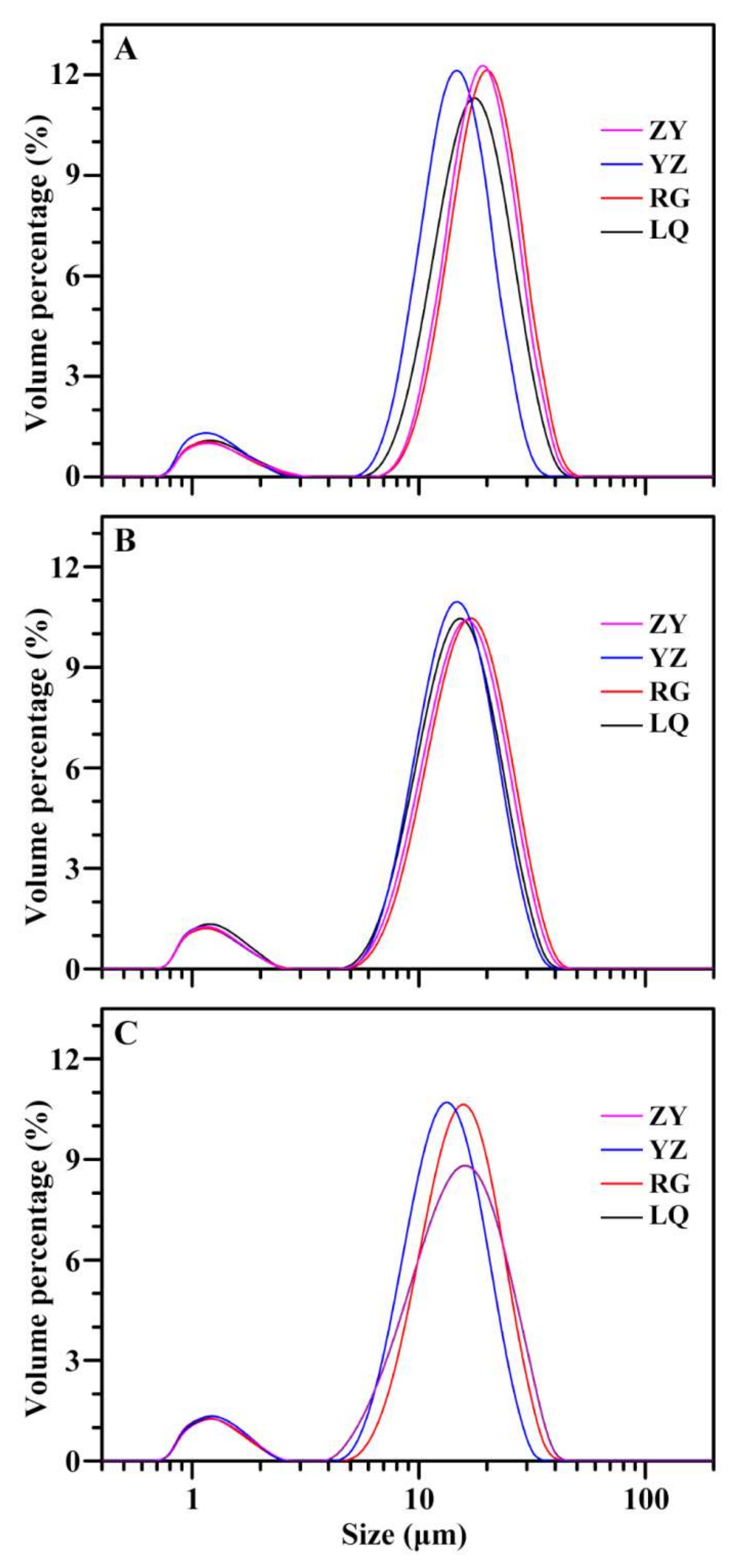
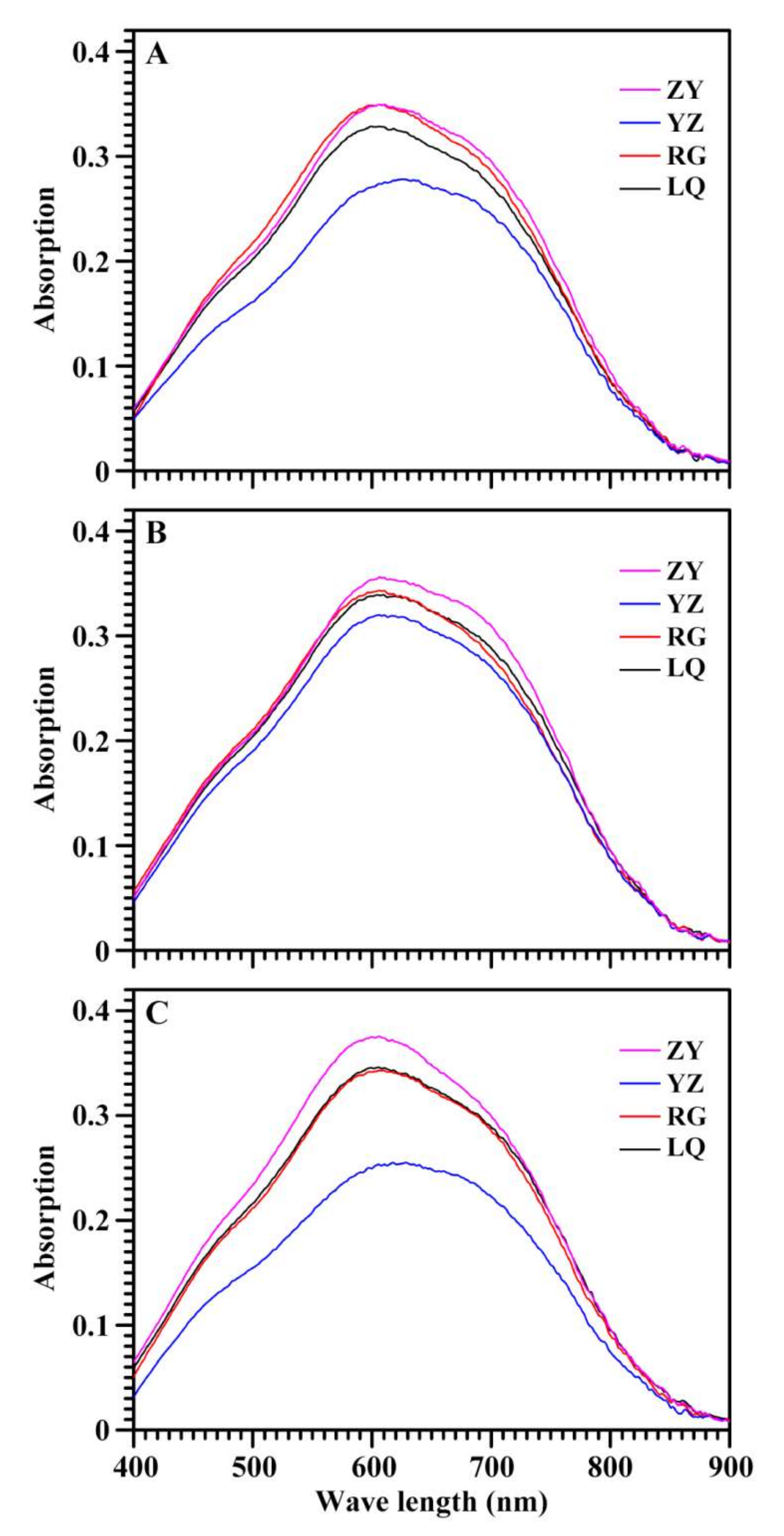
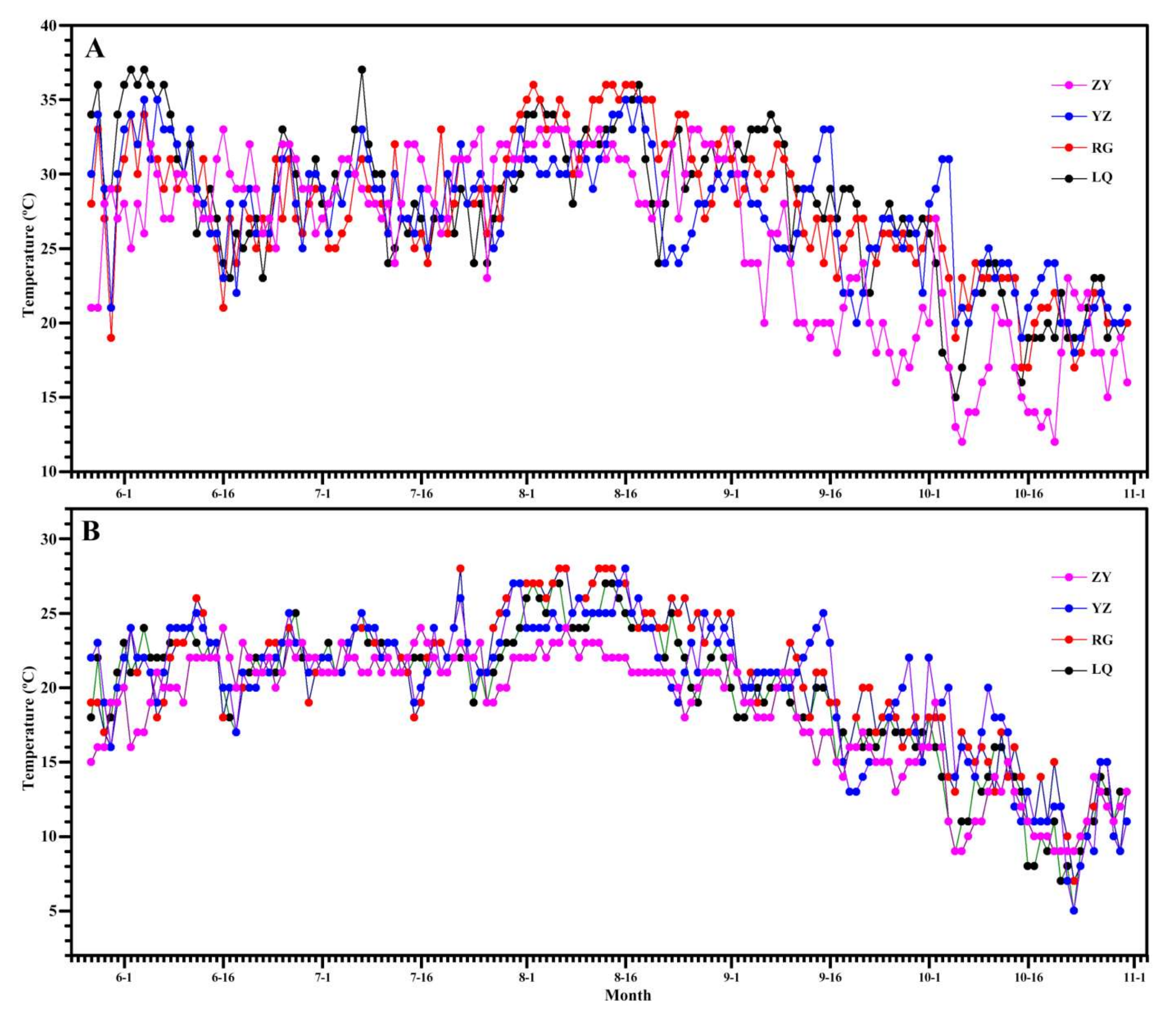
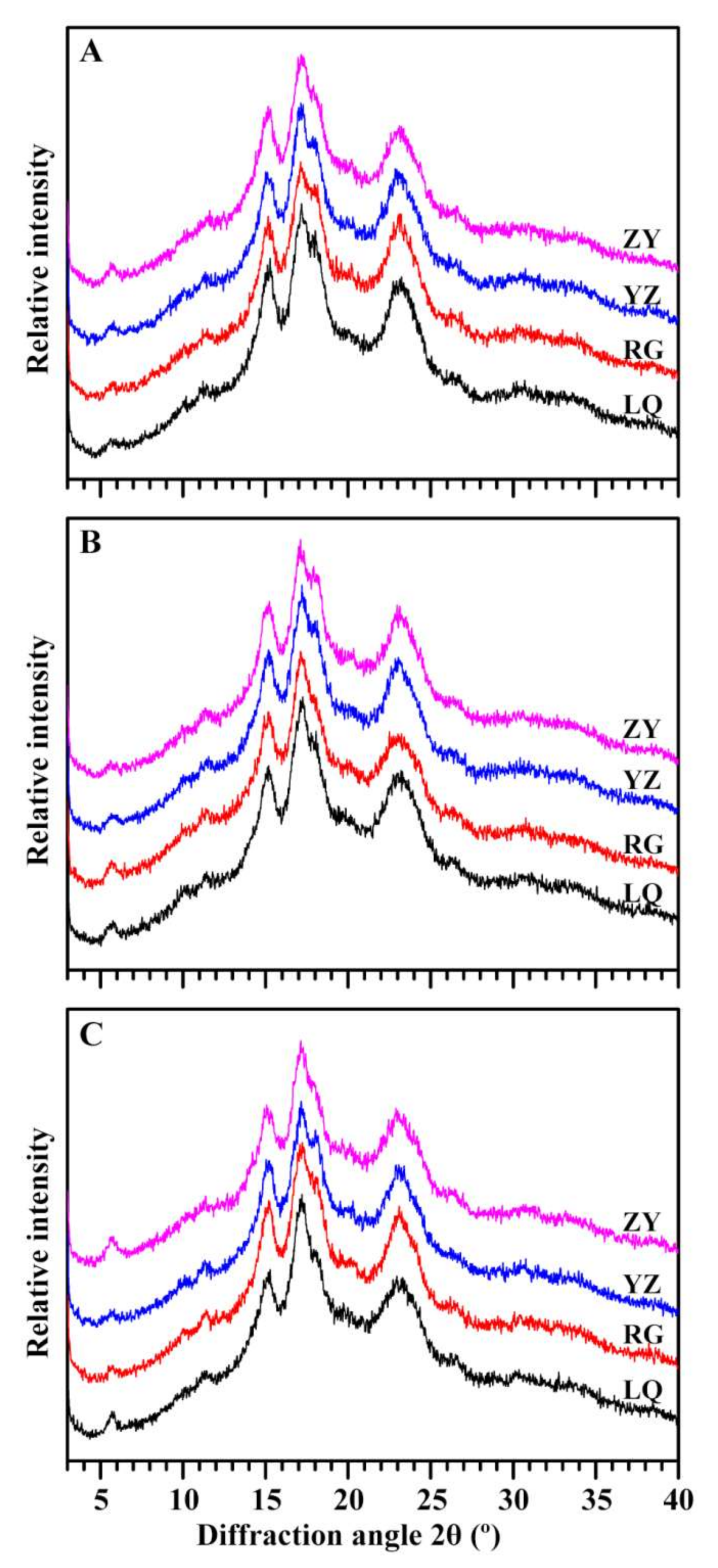
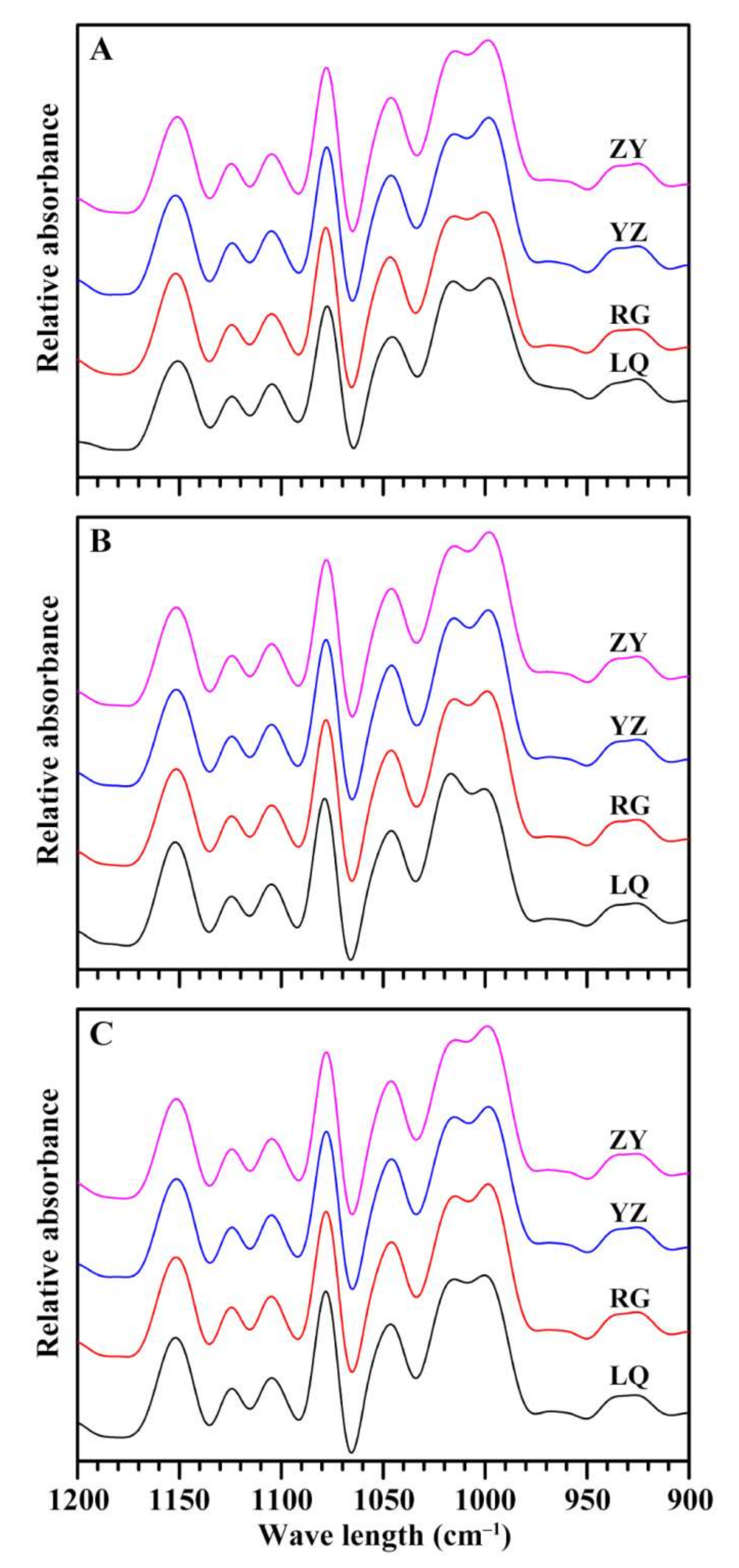
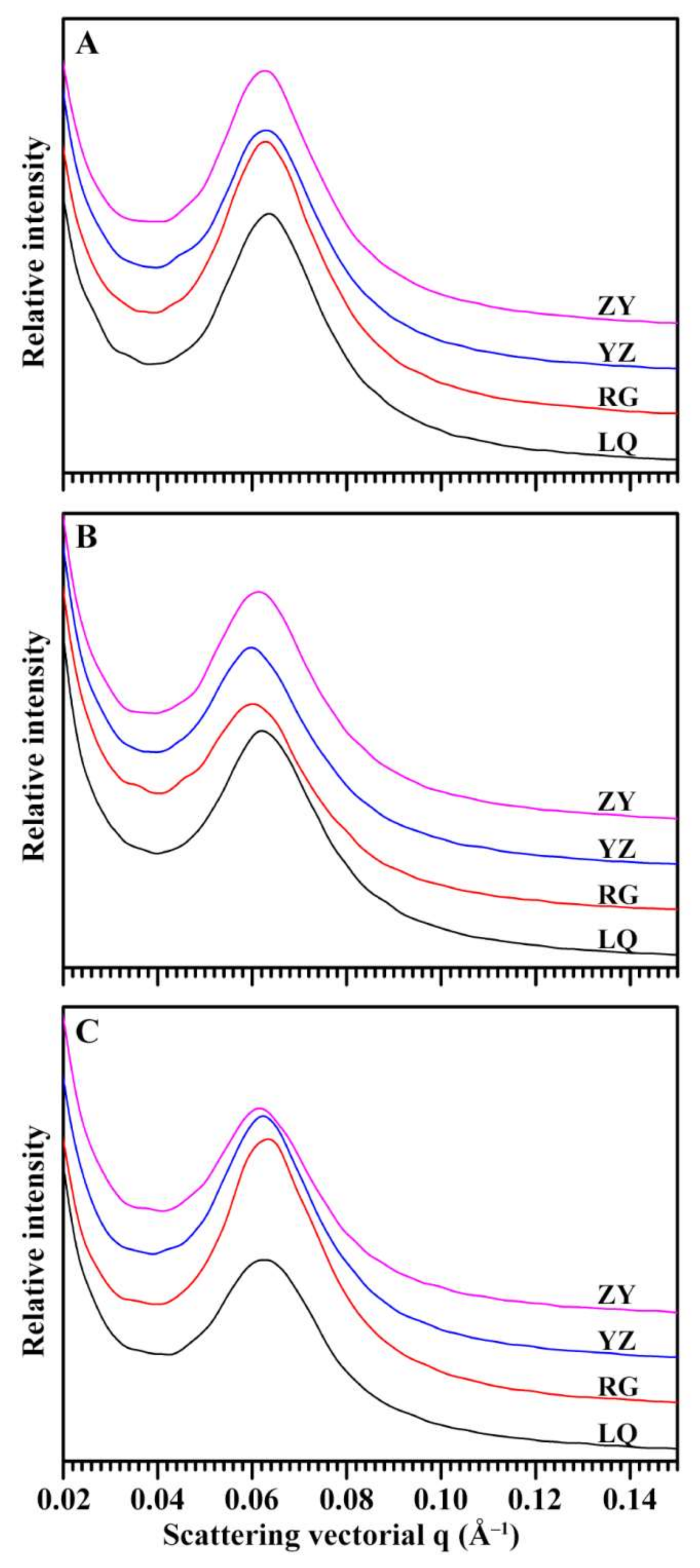
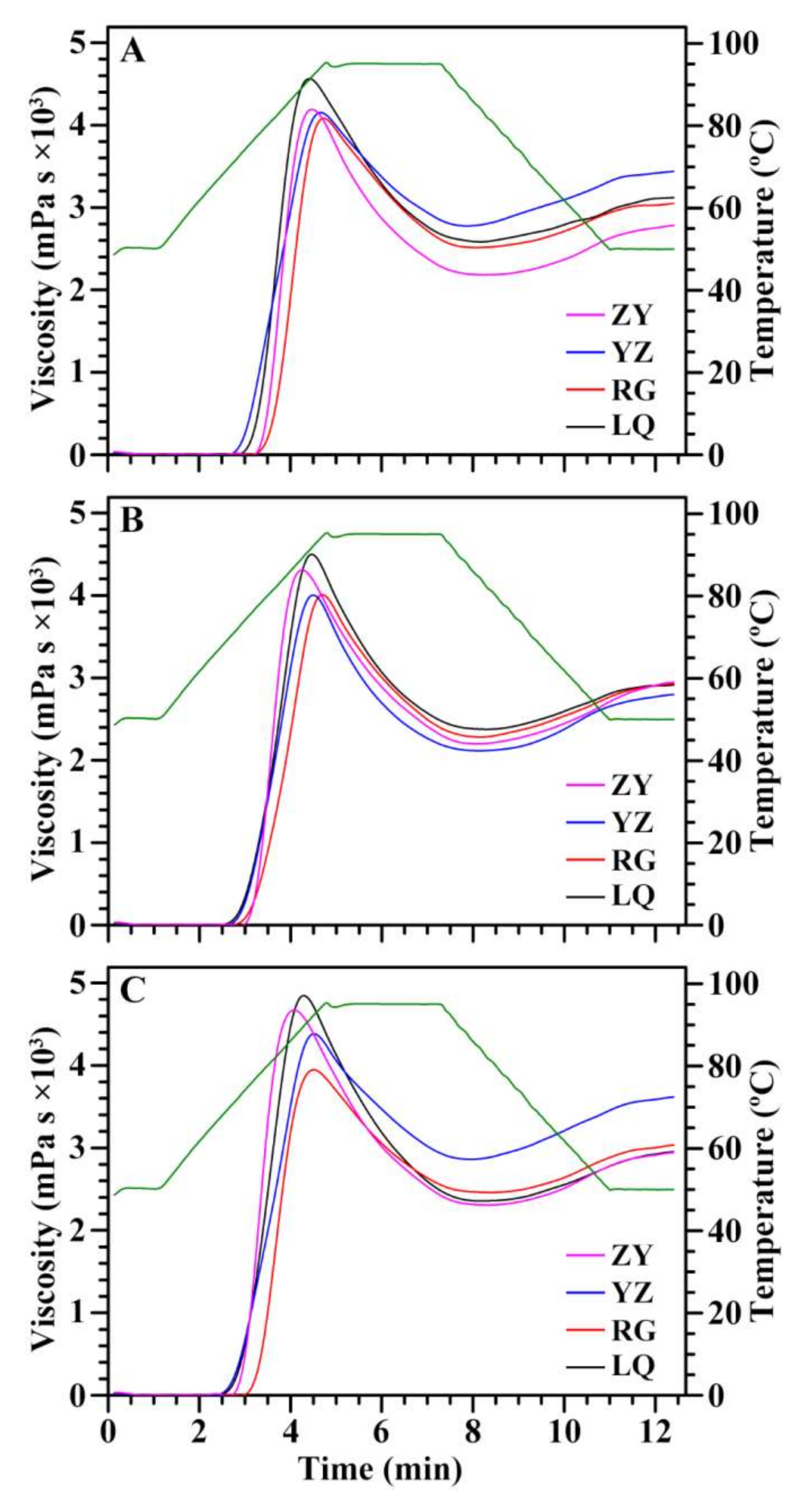

| Variety | Location | D[4,3] (μm) | Iodine Absorption Parameters | AC (%) | |||
|---|---|---|---|---|---|---|---|
| OD620 | OD680 | OD620/550 | λmax (nm) | ||||
| Ningzishu 1 | LQ | 16.06 ± 0.01iB | 0.332 ± 0.010bcB | 0.297 ± 0.005bB | 1.145 ± 0.017abA | 606.5 ± 0.5aA | 16.4 ± 0.9aA |
| RG | 18.22 ± 0.02kD | 0.339 ± 0.010bcdB | 0.302 ± 0.006bcB | 1.156 ± 0.033abcA | 606.1 ± 0.2aA | 16.6 ± 0.3aA | |
| YZ | 13.33 ± 0.01bA | 0.275 ± 0.002aA | 0.257 ± 0.005aA | 1.232 ± 0.021efB | 625.6 ± 2.4dB | 16.7 ± 0.3aA | |
| ZY | 17.50 ± 0.02jC | 0.361 ± 0.005eC | 0.321 ± 0.004deC | 1.128 ± 0.021aA | 606.4 ± 0.4aA | 17.7 ± 0.4abA | |
| Sushu 16 | LQ | 13.79 ± 0.01dB | 0.339 ± 0.002bcdB | 0.308 ± 0.004bcdAB | 1.196 ± 0.006cdeA | 613.9 ± 2.6cB | 18.4 ± 0.1bcA |
| RG | 15.39 ± 0.01hD | 0.339 ± 0.010bcdB | 0.308 ± 0.011bcdAB | 1.193 ± 0.021bcdeA | 609.3 ± 0.8abA | 19.5 ± 0.5cdeA | |
| YZ | 13.53 ± 0.02cA | 0.322 ± 0.005bA | 0.294 ± 0.007bA | 1.208 ± 0.006defA | 609.2 ± 2.0abA | 19.0 ± 0.4bcdA | |
| ZY | 14.75 ± 0.03gC | 0.353 ± 0.003deB | 0.326 ± 0.007eB | 1.235 ± 0.006efB | 610.7 ± 0.4bcAB | 21.2 ± 0.2fB | |
| Sushu 28 | LQ | 14.14 ± 0.01eB | 0.334 ± 0.010bcdB | 0.302 ± 0.010bcB | 1.175 ± 0.015abcdA | 611.1 ± 0.6bcB | 19.8 ± 0.6cdefAB |
| RG | 14.19 ± 0.01fC | 0.333 ± 0.007bcB | 0.298 ± 0.006bB | 1.178 ± 0.010bcdA | 606.8 ± 1.2aA | 21.1 ± 0.3efB | |
| YZ | 12.11 ± 0.01aA | 0.260 ± 0.006aA | 0.243 ± 0.004aA | 1.252 ± 0.026fB | 629.0 ± 2.4eC | 18.3 ± 0.6bcA | |
| ZY | 14.13 ± 0.02eB | 0.347 ± 0.003cdeB | 0.316 ± 0.003cdeC | 1.191 ± 0.016bcdeA | 606.4 ± 0.4aA | 20.3 ± 0.3defB | |
| F-value | Variety (2) | 94054.64 *** | 25.00 *** | 29.17 *** | 18.10 *** | 10.95 *** | 109.55 *** |
| Location (3) | 63443.40 *** | 161.64 *** | 120.35 *** | 19.68 *** | 180.67 *** | 19.14 *** | |
| Variety × Location (6) | 9144.67 *** | 15.41 *** | 9.15 *** | 7.02 *** | 61.03 *** | 5.93 ** | |
| Variety | Location | RC (%) | IR Ratio | Lamellar Parameters | ||
|---|---|---|---|---|---|---|
| 1045/1022 (cm−1) | 1022/995 (cm−1) | PI (a.u.) | D (nm) | |||
| Ningzishu 1 | LQ | 26.2 ± 0.9aA | 0.650 ± 0.002abA | 0.974 ± 0.005efC | 382.3 ± 2.0cdB | 9.72 ± 0.00aA |
| RG | 25.0 ± 1.3aA | 0.699 ± 0.013deB | 0.983 ± 0.015fC | 418.6 ± 0.6dC | 9.80 ± 0.01abcBC | |
| YZ | 25.3 ± 0.7aA | 0.709 ± 0.006deB | 0.896 ± 0.003aA | 357.1 ± 3.0bcA | 9.78 ± 0.00abcB | |
| ZY | 24.5 ± 0.5aA | 0.676 ± 0.012bcdAB | 0.934 ± 0.005bcdB | 384.8 ± 4.6cdB | 9.82 ± 0.02abcC | |
| Sushu 16 | LQ | 24.9 ± 1.9aA | 0.634 ± 0.001aA | 1.103 ± 0.009gB | 331.2 ± 1.5bC | 9.86 ± 0.03bcA |
| RG | 22.8 ± 1.7aA | 0.659 ± 0.004abcA | 0.954 ± 0.010deA | 257.7 ± 7.3aA | 10.15 ± 0.02eC | |
| YZ | 24.3 ± 0.1aA | 0.702 ± 0.012deB | 0.945 ± 0.002cdA | 289.2 ± 0.8aB | 10.21 ± 0.01eC | |
| ZY | 24.9 ± 0.3aA | 0.697 ± 0.014deB | 0.922 ± 0.014bcA | 332.4 ± 4.7bC | 10.02 ± 0.01dB | |
| Sushu 28 | LQ | 23.7 ± 0.4aA | 0.678 ± 0.007bcdA | 0.977 ± 0.005efC | 275.5 ± 8.3aA | 9.87 ± 0.08bcA |
| RG | 26.2 ± 0.8aA | 0.695 ± 0.012cdeA | 0.925 ± 0.002bcB | 417.8 ± 7.2dB | 9.76 ± 0.01abA | |
| YZ | 24.7 ± 0.8aA | 0.726 ± 0.019eA | 0.931 ± 0.003bcdB | 332.0 ± 35.1bA | 9.88 ± 0.00cA | |
| ZY | 23.4 ± 1.3aA | 0.703 ± 0.012deA | 0.911 ± 0.003abA | 283.2 ± 1.6aA | 9.89 ± 0.07cA | |
| F-value | Variety (2) | 2.15 | 13.42 ** | 73.34 *** | 119.16 *** | 163.16 *** |
| Location (3) | 0.46 | 30.45 *** | 197.87 *** | 15.42 *** | 18.20 *** | |
| Variety × Location (6) | 2.69 | 3.33 * | 52.74 *** | 43.11 *** | 18.96 *** | |
| Variety | Location | PV (mPa s) | HV (mPa s) | BV (mPa s) | FV (mPa s) | SV (mPa s) | PTemp (°C) | PTime (min) |
|---|---|---|---|---|---|---|---|---|
| Ningzishu 1 | LQ | 4635 ± 29 gC | 2546 ± 27eC | 2090 ± 29eC | 3087 ± 51cB | 541 ± 25aA | 75.47 ± 0.45eB | 4.40 ± 0.07cA |
| RG | 4171 ± 20bcdA | 2478 ± 27dB | 1693 ± 45bB | 3034 ± 17cB | 556 ± 11abA | 78.73 ± 0.46gC | 4.60 ± 0.07dB | |
| YZ | 4293 ± 65defB | 2788 ± 26fD | 1504 ± 43aA | 3471 ± 42dC | 682 ± 16deC | 73.08 ± 0.51cA | 4.62 ± 0.04dB | |
| ZY | 4273 ± 26cdeB | 2171 ± 16aA | 2102 ± 10eC | 2802 ± 21aA | 631 ± 24bcdB | 78.98 ± 0.08gC | 4.42 ± 0.08cA | |
| Sushu 16 | LQ | 4656 ± 63gC | 2363 ± 42cB | 2293 ± 45fD | 2925 ± 12bB | 562 ± 49abA | 71.68 ± 0.03bA | 4.42 ± 0.04cB |
| RG | 4145 ± 34bcA | 2306 ± 28bcB | 1839 ± 28cA | 2938 ± 13bB | 633 ± 20bcdAB | 74.18 ± 0.03dC | 4.60 ± 0.01dC | |
| YZ | 4102 ± 25bA | 2113 ± 29aA | 1989 ± 7dB | 2769 ± 26aA | 656 ± 33cdB | 72.47 ± 0.03bcB | 4.47 ± 0.01cB | |
| ZY | 4383 ± 42efB | 2178 ± 16aA | 2205 ± 39fC | 2947 ± 36bB | 769 ± 43fC | 76.05 ± 0.48efD | 4.22 ± 0.04bA | |
| Sushu 28 | LQ | 4929 ± 52hD | 2338 ± 39bcA | 2591 ± 14hC | 2942 ± 55bA | 604 ± 16abcdA | 70.55 ± 0.48aA | 4.20 ± 0.07bB |
| RG | 3918 ± 89aA | 2439 ± 26dB | 1479 ± 64aA | 3026 ± 21cB | 587 ± 45abcA | 76.88 ± 0.45fC | 4.51 ± 0.04cdC | |
| YZ | 4415 ± 79fB | 2846 ± 36fC | 1569 ± 44aA | 3579 ± 35eC | 733 ± 32efB | 70.07 ± 0.06aA | 4.44 ± 0.04cC | |
| ZY | 4739 ± 40gC | 2274 ± 22bA | 2465 ± 43gB | 2920 ± 25bA | 645 ± 6 cd A | 72.80 ± 0.52cB | 4.07 ± 0.07aA | |
| F-value | Variety (2) | 42.75 *** | 289.82 *** | 125.27 *** | 173.57 *** | 10.11 ** | 384.62 *** | 49.45 *** |
| Location (3) | 268.63 *** | 254.21 *** | 787.49 *** | 233.50 *** | 38.92 *** | 377.46 *** | 81.60 *** | |
| Variety × Location (6) | 34.44 *** | 131.76 *** | 98.02 *** | 142.61 *** | 7.75 *** | 50.46 *** | 6.17 ** |
| Varieties | Locations | SP (g/g) | WS (%) | Thermal Property Parameters | ||||
|---|---|---|---|---|---|---|---|---|
| To (°C) | Tp (°C) | Tc (°C) | ΔT (°C) | ΔH (J/g) | ||||
| Ningzishu 1 | LQ | 30.9 ± 0.2cA | 12.7 ± 0.5aA | 59.9 ± 0.1gB | 73.3 ± 0.1fB | 80.8 ± 0.1cA | 20.9 ± 0.2bA | 14.3 ± 0.1cB |
| RG | 29.9 ± 0.9bcA | 12.5 ± 0.6aA | 62.9 ± 0.1hC | 77.2 ± 0.3gD | 84.0 ± 0.5fC | 21.1 ± 0.3bA | 14.2 ± 0.1cB | |
| YZ | 30.1 ± 0.7bcA | 12.9 ± 0.5aA | 57.6 ± 0.1fA | 69.5 ± 0.6deA | 82.1 ± 0.4deB | 24.5 ± 0.4cdC | 13.2 ± 0.6abcA | |
| ZY | 30.2 ± 0.6bcA | 14.4 ± 0.7bcB | 60.1 ± 0.1gB | 76.2 ± 0.2gC | 83.3 ± 0.3efC | 23.1 ± 0.2cB | 14.1 ± 0.5cB | |
| Sushu 16 | LQ | 32.6 ± 0.6dB | 15.4 ± 0.1cA | 54.8 ± 0.2cA | 61.2 ± 0.2aA | 80.9 ± 0.4cA | 26.1 ± 0.3eB | 13.2 ± 0.6abcA |
| RG | 29.9 ± 0.6bcA | 15.2 ± 0.8cA | 57.7 ± 0.5fC | 70.0 ± 0.9eC | 83.0 ± 0.3efB | 25.3 ± 0.6deB | 12.2 ± 0.6abA | |
| YZ | 29.8 ± 0.5bcA | 14.2 ± 0.5bcA | 55.7 ± 0.4dB | 68.7 ± 0.4dB | 82.3 ± 0.7deB | 26.6 ± 0.9eB | 12.7 ± 0.4abcA | |
| ZY | 29.1 ± 0.4bA | 17.9 ± 0.6dB | 62.8 ± 0.2hD | 73.0 ± 0.4fB | 80.7 ± 0.5cA | 17.9 ± 0.6aA | 13.3 ± 0.7bcA | |
| Sushu 28 | LQ | 28.9 ± 0.2bB | 13.5 ± 0.1abA | 53.1 ± 0.1bB | 66.4 ± 0.5cB | 77.4 ± 0.4aA | 24.3 ± 0.4cdB | 12.8 ± 0.7abcA |
| RG | 27.4 ± 0.5aA | 14.6 ± 0.1bcB | 57.9 ± 0.2fD | 73.5 ± 0.3fD | 81.5 ± 0.3cdC | 23.6 ± 0.4cB | 13.3 ± 0.7bcA | |
| YZ | 26.7 ± 0.4aA | 12.8 ± 0.4aA | 51.1 ± 0.3aA | 64.1 ± 0.4bA | 79.2 ± 0.9bB | 28.1 ± 1.1fC | 11.7 ± 0.7aA | |
| ZY | 29.8 ± 0.5bcB | 15.3 ± 0.6cB | 56.5 ± 0.4eC | 69.1 ± 0.2deC | 77.3 ± 0.2aA | 20.9 ± 0.2bA | 12.9 ± 0.6abcA | |
| F-value | Variety (2) | 62.68 *** | 75.16 *** | 1467.13 *** | 796.78 *** | 205.24 *** | 41.10 *** | 18.39 *** |
| Location (3) | 23.27 *** | 41.71 *** | 911.93 *** | 644.24 *** | 73.36 *** | 173.62 *** | 5.29 ** | |
| Variety × Location (6) | 11.76 *** | 4.42 ** | 195.71 *** | 157.12 *** | 11.25 *** | 62.30 *** | 2.78 * | |
| Varieties | Locations | Native Starch | Gelatinized Starch | ||||
|---|---|---|---|---|---|---|---|
| RDS (%) | SDS (%) | RS (%) | RDS (%) | SDS (%) | RS (%) | ||
| Ningzishu 1 | LQ | 3.2 ± 0.1cC | 10.3 ± 0.3aB | 86.5 ± 0.4gB | 70.5 ± 1.1aA | 6.2 ± 0.5bcAB | 23.3 ± 1.5eB |
| RG | 2.7 ± 0.1bB | 9.2 ± 0.2aA | 88.1 ± 0.3ghC | 72.9 ± 0.9abcAB | 7.9 ± 0.2cdB | 19.2 ± 1.1cdA | |
| YZ | 5.1 ± 0.1fD | 16.6 ± 0.6cC | 78.3 ± 0.7deA | 75.0 ± 1.6bcdB | 7.7 ± 0.5cdB | 17.3 ± 1.4cA | |
| ZY | 2.2 ± 0.1aA | 8.8 ± 0.3aA | 89.1 ± 0.4hC | 74.4 ± 1.8bcdB | 5.5 ± 1.6bA | 20.1 ± 0.2dA | |
| Sushu 16 | LQ | 5.0 ± 0.1fC | 18.3 ± 0.4dB | 76.6 ± 0.5dB | 78.4 ± 0.6efB | 10.2 ± 0.3efAB | 11.5 ± 0.8abA |
| RG | 4.1 ± 0.1dB | 16.3 ± 0.6bcA | 79.6 ± 0.7efC | 76.0 ± 1.3cdeB | 10.7 ± 0.7fB | 13.3 ± 0.6bB | |
| YZ | 7.9 ± 0.3hD | 29.6 ± 0.9eC | 62.5 ± 1.1bA | 77.1 ± 0.7deB | 11.0 ± 0.4fB | 11.8 ± 0.4abA | |
| ZY | 3.3 ± 0.2cA | 16.6 ± 0.2cA | 80.0 ± 0.4efC | 72.6 ± 2.0abA | 8.2 ± 1.8cdA | 19.2 ± 0.3cdC | |
| Sushu 28 | LQ | 6.5 ± 0.2gB | 19.0 ± 0.6dB | 74.5 ± 0.9cB | 80.7 ± 0.6fB | 8.5 ± 0.3deC | 10.8 ± 0.8aA |
| RG | 4.6 ± 0.0eA | 15.1 ± 0.0bcA | 80.3 ± 0.1efC | 78.3 ± 1.5efA | 2.1 ± 0.8aA | 19.6 ± 1.1dB | |
| YZ | 10.9 ± 0.3iC | 30.9 ± 1.4eC | 58.2 ± 1.6aA | 81.1 ± 0.3fB | 7.9 ± 0.3cdC | 11.0 ± 0.5aA | |
| ZY | 4.6 ± 0.1eA | 14.7 ± 0.8bA | 80.6 ± 0.9fC | 81.4 ± 0.2fB | 6.7 ± 0.3bcdB | 12.0 ± 0.4abA | |
| F-value | Variety (2) | 361.59 *** | 1267.42 *** | 745.02 *** | 109.19 *** | 75.68 *** | 220.52 *** |
| Location (3) | 125.27 *** | 1425.86 *** | 727.37 *** | 4.77 ** | 14.92 *** | 42.25 *** | |
| Variety × Location (6) | 9.16 *** | 88.32 *** | 29.75 *** | 10.29 *** | 19.44 *** | 54.79 *** | |
Publisher’s Note: MDPI stays neutral with regard to jurisdictional claims in published maps and institutional affiliations. |
© 2021 by the authors. Licensee MDPI, Basel, Switzerland. This article is an open access article distributed under the terms and conditions of the Creative Commons Attribution (CC BY) license (https://creativecommons.org/licenses/by/4.0/).
Share and Cite
Shi, L.; Li, Y.; Lin, L.; Bian, X.; Wei, C. Effects of Variety and Growing Location on Physicochemical Properties of Starch from Sweet Potato Root Tuber. Molecules 2021, 26, 7137. https://doi.org/10.3390/molecules26237137
Shi L, Li Y, Lin L, Bian X, Wei C. Effects of Variety and Growing Location on Physicochemical Properties of Starch from Sweet Potato Root Tuber. Molecules. 2021; 26(23):7137. https://doi.org/10.3390/molecules26237137
Chicago/Turabian StyleShi, Laiquan, Yibo Li, Lingshang Lin, Xiaofeng Bian, and Cunxu Wei. 2021. "Effects of Variety and Growing Location on Physicochemical Properties of Starch from Sweet Potato Root Tuber" Molecules 26, no. 23: 7137. https://doi.org/10.3390/molecules26237137
APA StyleShi, L., Li, Y., Lin, L., Bian, X., & Wei, C. (2021). Effects of Variety and Growing Location on Physicochemical Properties of Starch from Sweet Potato Root Tuber. Molecules, 26(23), 7137. https://doi.org/10.3390/molecules26237137






